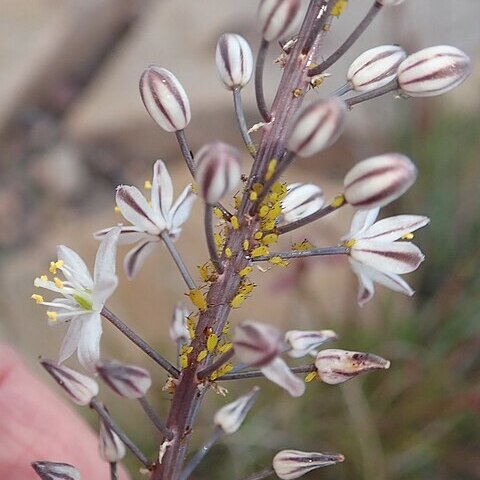Plants deciduous, solitary or rarely clumped. Bulb subglobose to ovoid, 25-70(-100) mm diam., scales tightly packed, outer scales thinly leathery, persisting in short or long, thick papery neck or collar with transverse abscission lines, flesh whitish to pink. Leaf usually synanthous, solitary (rarely 2), suberect, cylindrical, 170-300 x (2)3-5(-10) mm, dark green, obtuse but withering from apex via transverse abscission plates, glabrous, sheathing base with broad, chestnut brown, papery margins. Inflorescence a moderately dense, elongate raceme 200-500(-600) mm tall, 15-to 80(100)-flowered, flowers sometimes in clusters, mostly 2-5 mm apart; scape glabrous, 1.5-5.0 mm diam.; bracts ovate-deltoid, 1.0-1.5 mm long, lowest with short spur 1-2(-5) mm long; pedicels spreading, (2-)3-5(-8) mm long; bracteoles absent. Flowers spreading, rotate or shallowly campanulate, unscented [scented fide Jessop 1977)]; tepals connate ± 1 mm, lobes either suberect below or spreading to slightly recurved from the base, elliptic to oblong, 4-5 x 1.5 mm, apices penicillate, white, yellowish or greenish to pale pink, with darker dorsal stripe, unscented. Filaments suberect or weakly spreading, subulate, 2.5-3.0 mm long, pale. Anthers medifixed, oblong, ± 1 mm long, yellowish green. Ovary ovoid-truncate to ellipsoid, 1.5-2.0 mm long, green; style columnar, 1.5-2.0 mm long, white; stigma truncate-papillate. Capsules ovoid to ellipsoid, obtuse to truncate, 4-6 mm long. Seeds strongly angled, 1.5-2.0 mm long, testa minutely reticulate.
More
Perennial geophyte, up to 0.8 m high; bulb up to 80 mm long, sheath scales tightly packed, white. Leaves synanthous, solitary, cylindrical, dark green, up to 300 x 4 mm. Inflorescence an elongate raceme, 14-18-flowered; bracts ± 1 mm long. Flowers: white, pinkish, beige, yellow or greenish, with a green to reddish dorsal stripe; tepals 4-5 mm long, fused for ± 1 mm, spreading or recurved. Stamens: filaments 2.5-3.0 mm long, erect-spreading, never connivent; anthers dorsifixed, ± 1 mm long. Ovary ovoid; style up to 2 mm long; stigma minutely capitate. Flowering time summer. Fruit an ellipsoid capsule, ± 6 mm long.
Bulbous geophyte to 50 cm, with banded, papery cataphylls, stems often scabrid below. Leaf usually present at flowering, solitary, erect, terete-cylindrical, firm. Flowers in a narrow raceme, whitish, beige or greenish, tepals slightly reflexed, faintly scented.

